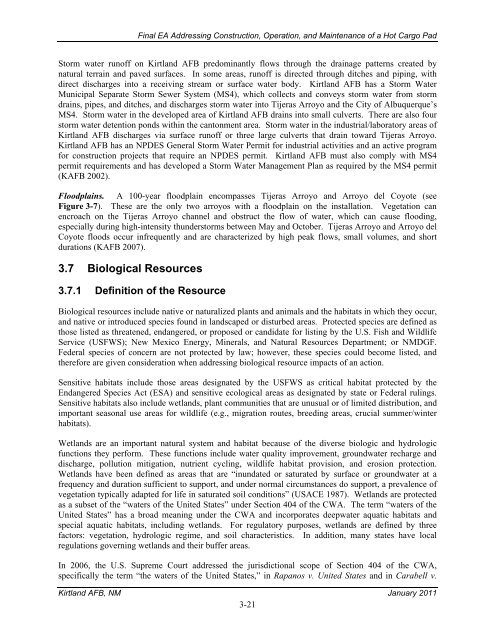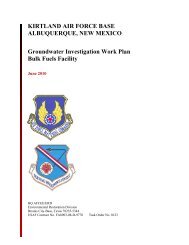Final FONSI and EA for hot cargo pad on Kirtland AFB - Kirtland Air ...
Final FONSI and EA for hot cargo pad on Kirtland AFB - Kirtland Air ...
Final FONSI and EA for hot cargo pad on Kirtland AFB - Kirtland Air ...
Create successful ePaper yourself
Turn your PDF publications into a flip-book with our unique Google optimized e-Paper software.
<str<strong>on</strong>g>Final</str<strong>on</strong>g> <str<strong>on</strong>g>EA</str<strong>on</strong>g> Addressing C<strong>on</strong>structi<strong>on</strong>, Operati<strong>on</strong>, <str<strong>on</strong>g>and</str<strong>on</strong>g> Maintenance of a Hot Cargo Pad<br />
Storm water runoff <strong>on</strong> Kirtl<str<strong>on</strong>g>and</str<strong>on</strong>g> <strong>AFB</strong> predominantly flows through the drainage patterns created by<br />
natural terrain <str<strong>on</strong>g>and</str<strong>on</strong>g> paved surfaces. In some areas, runoff is directed through ditches <str<strong>on</strong>g>and</str<strong>on</strong>g> piping, with<br />
direct discharges into a receiving stream or surface water body. Kirtl<str<strong>on</strong>g>and</str<strong>on</strong>g> <strong>AFB</strong> has a Storm Water<br />
Municipal Separate Storm Sewer System (MS4), which collects <str<strong>on</strong>g>and</str<strong>on</strong>g> c<strong>on</strong>veys storm water from storm<br />
drains, pipes, <str<strong>on</strong>g>and</str<strong>on</strong>g> ditches, <str<strong>on</strong>g>and</str<strong>on</strong>g> discharges storm water into Tijeras Arroyo <str<strong>on</strong>g>and</str<strong>on</strong>g> the City of Albuquerque’s<br />
MS4. Storm water in the developed area of Kirtl<str<strong>on</strong>g>and</str<strong>on</strong>g> <strong>AFB</strong> drains into small culverts. There are also four<br />
storm water detenti<strong>on</strong> p<strong>on</strong>ds within the cant<strong>on</strong>ment area. Storm water in the industrial/laboratory areas of<br />
Kirtl<str<strong>on</strong>g>and</str<strong>on</strong>g> <strong>AFB</strong> discharges via surface runoff or three large culverts that drain toward Tijeras Arroyo.<br />
Kirtl<str<strong>on</strong>g>and</str<strong>on</strong>g> <strong>AFB</strong> has an NPDES General Storm Water Permit <str<strong>on</strong>g>for</str<strong>on</strong>g> industrial activities <str<strong>on</strong>g>and</str<strong>on</strong>g> an active program<br />
<str<strong>on</strong>g>for</str<strong>on</strong>g> c<strong>on</strong>structi<strong>on</strong> projects that require an NPDES permit. Kirtl<str<strong>on</strong>g>and</str<strong>on</strong>g> <strong>AFB</strong> must also comply with MS4<br />
permit requirements <str<strong>on</strong>g>and</str<strong>on</strong>g> has developed a Storm Water Management Plan as required by the MS4 permit<br />
(K<strong>AFB</strong> 2002).<br />
Floodplains. A 100-year floodplain encompasses Tijeras Arroyo <str<strong>on</strong>g>and</str<strong>on</strong>g> Arroyo del Coyote (see<br />
Figure 3-7). These are the <strong>on</strong>ly two arroyos with a floodplain <strong>on</strong> the installati<strong>on</strong>. Vegetati<strong>on</strong> can<br />
encroach <strong>on</strong> the Tijeras Arroyo channel <str<strong>on</strong>g>and</str<strong>on</strong>g> obstruct the flow of water, which can cause flooding,<br />
especially during high-intensity thunderstorms between May <str<strong>on</strong>g>and</str<strong>on</strong>g> October. Tijeras Arroyo <str<strong>on</strong>g>and</str<strong>on</strong>g> Arroyo del<br />
Coyote floods occur infrequently <str<strong>on</strong>g>and</str<strong>on</strong>g> are characterized by high peak flows, small volumes, <str<strong>on</strong>g>and</str<strong>on</strong>g> short<br />
durati<strong>on</strong>s (K<strong>AFB</strong> 2007).<br />
3.7 Biological Resources<br />
3.7.1 Definiti<strong>on</strong> of the Resource<br />
Biological resources include native or naturalized plants <str<strong>on</strong>g>and</str<strong>on</strong>g> animals <str<strong>on</strong>g>and</str<strong>on</strong>g> the habitats in which they occur,<br />
<str<strong>on</strong>g>and</str<strong>on</strong>g> native or introduced species found in l<str<strong>on</strong>g>and</str<strong>on</strong>g>scaped or disturbed areas. Protected species are defined as<br />
those listed as threatened, endangered, or proposed or c<str<strong>on</strong>g>and</str<strong>on</strong>g>idate <str<strong>on</strong>g>for</str<strong>on</strong>g> listing by the U.S. Fish <str<strong>on</strong>g>and</str<strong>on</strong>g> Wildlife<br />
Service (USFWS); New Mexico Energy, Minerals, <str<strong>on</strong>g>and</str<strong>on</strong>g> Natural Resources Department; or NMDGF.<br />
Federal species of c<strong>on</strong>cern are not protected by law; however, these species could become listed, <str<strong>on</strong>g>and</str<strong>on</strong>g><br />
there<str<strong>on</strong>g>for</str<strong>on</strong>g>e are given c<strong>on</strong>siderati<strong>on</strong> when addressing biological resource impacts of an acti<strong>on</strong>.<br />
Sensitive habitats include those areas designated by the USFWS as critical habitat protected by the<br />
Endangered Species Act (ESA) <str<strong>on</strong>g>and</str<strong>on</strong>g> sensitive ecological areas as designated by state or Federal rulings.<br />
Sensitive habitats also include wetl<str<strong>on</strong>g>and</str<strong>on</strong>g>s, plant communities that are unusual or of limited distributi<strong>on</strong>, <str<strong>on</strong>g>and</str<strong>on</strong>g><br />
important seas<strong>on</strong>al use areas <str<strong>on</strong>g>for</str<strong>on</strong>g> wildlife (e.g., migrati<strong>on</strong> routes, breeding areas, crucial summer/winter<br />
habitats).<br />
Wetl<str<strong>on</strong>g>and</str<strong>on</strong>g>s are an important natural system <str<strong>on</strong>g>and</str<strong>on</strong>g> habitat because of the diverse biologic <str<strong>on</strong>g>and</str<strong>on</strong>g> hydrologic<br />
functi<strong>on</strong>s they per<str<strong>on</strong>g>for</str<strong>on</strong>g>m. These functi<strong>on</strong>s include water quality improvement, groundwater recharge <str<strong>on</strong>g>and</str<strong>on</strong>g><br />
discharge, polluti<strong>on</strong> mitigati<strong>on</strong>, nutrient cycling, wildlife habitat provisi<strong>on</strong>, <str<strong>on</strong>g>and</str<strong>on</strong>g> erosi<strong>on</strong> protecti<strong>on</strong>.<br />
Wetl<str<strong>on</strong>g>and</str<strong>on</strong>g>s have been defined as areas that are “inundated or saturated by surface or groundwater at a<br />
frequency <str<strong>on</strong>g>and</str<strong>on</strong>g> durati<strong>on</strong> sufficient to support, <str<strong>on</strong>g>and</str<strong>on</strong>g> under normal circumstances do support, a prevalence of<br />
vegetati<strong>on</strong> typically adapted <str<strong>on</strong>g>for</str<strong>on</strong>g> life in saturated soil c<strong>on</strong>diti<strong>on</strong>s” (USACE 1987). Wetl<str<strong>on</strong>g>and</str<strong>on</strong>g>s are protected<br />
as a subset of the “waters of the United States” under Secti<strong>on</strong> 404 of the CWA. The term “waters of the<br />
United States” has a broad meaning under the CWA <str<strong>on</strong>g>and</str<strong>on</strong>g> incorporates deepwater aquatic habitats <str<strong>on</strong>g>and</str<strong>on</strong>g><br />
special aquatic habitats, including wetl<str<strong>on</strong>g>and</str<strong>on</strong>g>s. For regulatory purposes, wetl<str<strong>on</strong>g>and</str<strong>on</strong>g>s are defined by three<br />
factors: vegetati<strong>on</strong>, hydrologic regime, <str<strong>on</strong>g>and</str<strong>on</strong>g> soil characteristics. In additi<strong>on</strong>, many states have local<br />
regulati<strong>on</strong>s governing wetl<str<strong>on</strong>g>and</str<strong>on</strong>g>s <str<strong>on</strong>g>and</str<strong>on</strong>g> their buffer areas.<br />
In 2006, the U.S. Supreme Court addressed the jurisdicti<strong>on</strong>al scope of Secti<strong>on</strong> 404 of the CWA,<br />
specifically the term “the waters of the United States,” in Rapanos v. United States <str<strong>on</strong>g>and</str<strong>on</strong>g> in Carabell v.<br />
Kirtl<str<strong>on</strong>g>and</str<strong>on</strong>g> <strong>AFB</strong>, NM January 2011<br />
3-21
















